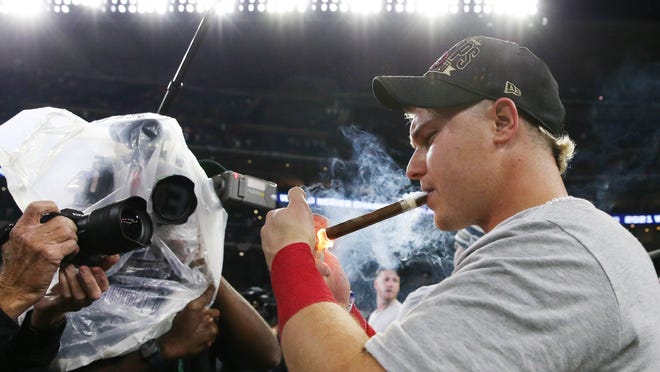Well, at least they are talking.
This time, instead of a face-off that lasted all of seven minutes during their last negotiation session Dec. 1, the video call Thursday afternoon between Major League Baseball and the Major League Baseball Players Association lasted more than an hour.
MLB, according to two persons with knowledge of the session, made three proposals addressing issues the union had raised in previous negotiations.
They spoke to USA TODAY Sports the condition of anonymity because the negotiations were not public.
MLB proposed to significantly increase pay to players with at least two years of major-league service who aren’t yet eligible for salary arbitration. Players who reach certain performance incentives would receive the largest pay increases.
Yet, in exchange, the top 22% of players in service time, called the Super 2 class, would no longer be eligible for arbitration. However, players with at least one day of service would be grandfathered into the current existing system. There currently are about 30 players who would fall in the Super 2 class. All players would be required to have at least three years of service before having salary arbitration rights.
There was also a proposal given to help end service-time manipulation involving a mechanism providing clubs extra draft picks as an incentive to promote prospects to the major leagues.
There also was a tweak to the draft-lottery proposal to prevent teams from automatically receiving the top draft picks for having the worst records.
There was no change to MLB’s last minimum-salary proposal of paying players $600,000 with one day of service, $650,000 with one year of service and $700,000 to players with at least two years. The minimum salary currently is $570,500.
MLB also informed the union that it would not reduce free agency from six years to five years or expand the player pool eligible for salary arbitration.
There also was no change on MLB’s current $214 million luxury tax proposal, an increase from $210 million, while the union seeks $245 million. The union is asking for a $100 million decrease in revenue sharing among clubs – which MLB owners adamantly refuse, believing it would only widen the financial divide between the large and small markets.
The union and several high-ranking players were unimpressed with the new proposals, and now will reconvene, trying to determine when they will meet again. MLB is expecting the union to make a counter to their proposals, perhaps next week.
The two sides realize they need to reach an agreement by the first week of February for spring training to start on time and prevent the postponement of spring training games. Spring training still is scheduled to start Feb. 16 with exhibition games beginning 10 days later.
There still are close to 300 free agents who need jobs, perhaps at least half who may have to take minor-league deals with 40-man rosters frozen during the lockout, and teams still need to fill out their rosters.
Players also will need at least 10 days to report to camp, work out visas for foreign players, while also going through COVID-19 protocols when they arrive to camp .
The date for a deal to be finalized without the loss of regular-season games is about March 5 with opening-day scheduled March 31.
There still are about three weeks before either side feels pressure to get a deal done, but urgency is starting to creep in.
The only real core economic issue they’ve agreed upon so far is MLB’s acceptance of the union’s pension and benefits proposal, although MLB has also informed the union it is willing to eliminate draft-pick compensation in free agency.
MLB has offered to adopt a universal DH, which paid an average salary of about $9 million year. The union has agreed to expand the postseason playoff pool from 10 teams to 12 teams while MLB wants a 14-team pool.
MLB argues that their proposals are designed to generate momentum to finding a path to reaching an agreement.
The union argues that the proposals don’t provide nearly enough money to the younger players, encourage competitiveness by all 30 teams, or dissuade teams from freely spending because of the luxury tax penalties.
Certainly, plenty of obstacles lay ahead with the clock ticking, but at least for the time in 42 days, they are talking.
Who knows, maybe next time, considering their New York offices are only blocks apart – they’ll even dare to meet face-to-face once again?



